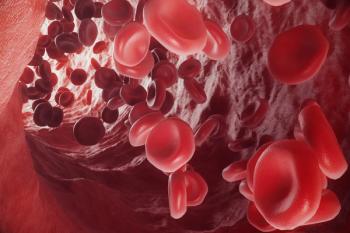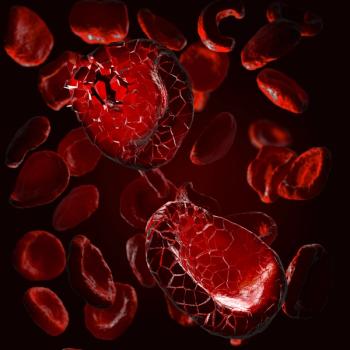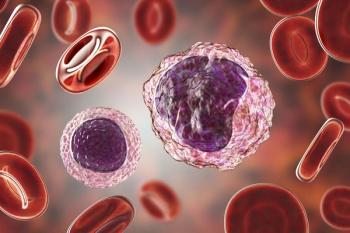
- ONCOLOGY Vol 12 No 5
- Volume 12
- Issue 5
Commentary (Basen-Engquist/Cohen): Quality of Life in Low-Grade Non-Hodgkin’s Lymphoma
Cancer treatment often has debilitating effects on the patients who receive it. Chemotherapy regimens can produce toxicities, such as gastrointestinal disturbances, hematologic deficiencies, fatigue, and neurotoxicity. Patients typically undergo these chemotherapy regimens to increase their disease-free survival time. Given that these therapies can negatively affect a patient’s quality of life (QOL), treatments need to provide clear curative potential and/or survival benefits to offset detrimental effects on QOL.
Cancer treatment often has debilitating effects on the patients who receive it. Chemotherapy regimens can produce toxicities, such as gastrointestinal disturbances, hematologic deficiencies, fatigue, and neurotoxicity. Patients typically undergo these chemotherapy regimens to increase their disease-free survival time. Given that these therapies can negatively affect a patient’s quality of life (QOL), treatments need to provide clear curative potential and/or survival benefits to offset detrimental effects on QOL.
Webster and Cella describe a case in which the benefits exchanged for the risks of therapy are unclear. As they describe, the therapies for low-grade non-Hodgkin’s lymphoma (NHL) do not provide a clear benefit in terms of cure or overall survival. The authors therefore conclude that extensive treatment may not be warranted because of the great impact of these therapies on QOL.
When Are the QOL Consequences of Treatment Important?
We concur with Webster and Cella that QOL should be considered when making treatment decisions. There are several clear-cut circumstances in which the effects of treatment on QOL become an important decision-making tool. For example, the QOL consequences of treatment are particularly significant when the treatments being considered yield similar advantages in survival but have different toxicities.[1] This appears to be the case for the treatment options for low-grade NHL, as described by Webster and Cella.
Multiple treatment options exist, including observation only, that have little effect on overall survival but a highly variable impact on QOL. However, these treatments do appear to differ in how they affect other disease related variables, such as the speed of treatment response and time to recurrence.
Although overall survival is usually considered to be the “bottom line” in evaluating therapies, treatment efficacy in terms of time to recurrence should not be underemphasized. For a patient facing the long-term management of a chronic, incurable disease, the amount of time that he or she remains free of disease or with stable disease may be important. This is particularly true if the disease itself produces debilitating symptoms. However, for patients whose disease does not manifest serious symptoms, as is the case for many individuals with low-grade NHL, the advantage provided by a longer time to progression may be primarily psychological.
According to Webster and Cella, for patients with low-grade NHL, progression is slow, symptoms are few, and therapies offer little survival advantage. Thus, the complexity of QOL considerations must be carefully evaluated.
To date, research on the QOL of patients with low-grade NHL is limited. Even the data presented by Webster and Cella are not specific to low-grade NHL. Thus, more research is needed before strong conclusions can be made about treatment strategies for low-grade NHL that optimize both medical benefit and QOL.
Assessing Patients’ Preferences
Although QOL may be compromised as the result of treatment, patients may be willing to endure these difficulties if therapy offers a longer symptom-free interval, or even the remote chance of cure or increased survival. The ambiguity surrounding the appropriateness of treatment for low-grade NHL indicates the need for information on patients’ preferences for treatment outcomes, taking into account both changes in QOL and life expectancy.
One group of methods for quantifying patient’s desires regarding treatment decisions is the assessment of utilities, or patient preferences. Utilities are used by decision scientists in evaluating treatment options based on a patient’s preference for a particular health state.[2] A patient-generated utility is a measure of the patient’s perception of the degree of impact of a particular outcome, such as neurologic problems or infertility. Utility is often assessed using such methods as the time trade-off, which seeks to determine the number of years of healthy life that a participant is willing to “trade off” for remaining free of an adverse health condition.
Utilities assess the value of a health state or outcome in reference to a universal standard, such as time, money, or risk of death.[3] This assessment technique is particularly useful when the same adverse event may be perceived differently by different people. These preferences can then be incorporated into formal decision-analytic models to determine the optimal treatment choice.
Need for Psychosocial Interventions
Even when treatment decisions take patient preferences into account, the management of the disease is likely to have consequences for patients’ QOL. Patients who receive aggressive treatment must cope with the difficult side effects of chemotherapy. Patients who opt for the strategy of “watchful waiting” may experience stress and anxiety related to not treating the disease.
The impact of low-grade NHL on patients’ QOL points to the need for psychosocial interventions to aid psychological adjustment and improve QOL. These programs may be implemented regardless of the treatment strategy chosen.
Several recent reviews have documented the effectiveness of psychosocial interventions in helping cancer patients adjust to their diagnosis and treatment.[4-7] Cognitive and behavioral interventions, such as guided imagery and progressive muscle relaxation, have been found to effectively reduce chemotherapy-induced symptoms and conditioned side effects, such as nausea and vomiting (see Fawzy et al[5]). In addition, cognitive-behavioral and more general support group-based interventions can be effective in improving psychological well-being and increasing overall survival time.[8,9] Group or individual psychosocial intervention programs can be useful at different stages of disease and treatment, and they need to be made available to all patients.
Although no studies have tested the use of such interventions to help patients cope with the stress of not treating a disease, this could be a fruitful area of research for both low-grade NHL and other cancer sites characterized by slow progression (eg, prostate cancer).
Treatment Risks vs Benefits
Although inclusion of QOL outcomes should be considered when making treatment decisions for diseases such as low-grade NHL, patients' preferences for the trade-off between treatment risks and benefits should also be considered. However, because current methods for assessing utilities are complex and may be impractical in some settings,[3] further methodologic research is needed to improve assessment techniques.
Patients need to be well informed of the consequences of a particular treatment decision, but they also need to be aware of the beneficial effects treatments can have on the disease process. Active involvement in group, individual, and/or personalized psychosocial intervention programs can be a useful adjunct to traditional medical treatment.
Unfortunately, for many patients, these types of programs are not available or affordable. Future research needs to definitively determine the cost-efficacy of these intervention programs so that they can be made available to all patients battling life-threatening illnesses.
References:
1. Nayfield SG, Ganz PA, Moinpour CM, et al: Report from a National Cancer Institute (USA) workshop on quality of life assessment in cancer clinical trials. Qual Life Res 1:203-210, 1992.
2. Cantor SB: Decision analysis: Theory and application to medicine. Prim Care 22:261-270, 1995.
3. Weeks J: Taking quality of life into account in health economic analyses. J Natl Cancer Inst Monogr 20:23-27, 1996.
4. Andersen BL: Psychological interventions for cancer patients to enhance the quality of life. J Consult Clin Psychol 60(4):552-568, 1992.
5. Fawzy IF, Fawzy NW, Arndt LA, et al: Critical review of psychosocial interventions in cancer care. Arch Gen Psychiatry 52:100-113, 1995.
6. Meyer TJ, Mark MM: Effects of psychosocial interventions with adult cancer patients: A meta-analysis of randomized experiments. Health Psychol 14(2):101-108, 1995.
7. Baum A, Herberman H, Cohen L: Managing stress and managing illness: Survival and quality of life in chronic disease. J Clin Psychol Med Set 2(4):309-333, 1995.
8. Fawzy FI, Fawzy NW, Hyun CS, et al: Malignant melanoma: Effects of an early structured psychiatric intervention, coping, and affective state on recurrence and survival 6 years later. Arch Gen Psychiatry 50:681-689, 1993.
9. Spiegel D, Bloom JR, Kraemer HC, et al: Effect of psychosocial treatment on survival of patients with metastatic breast cancer. Lancet 2:888-891, 1989.
Articles in this issue
over 27 years ago
AIDS Among Persons Age ≥ 50 Years—United States, 1991-1996over 27 years ago
Resource Guide for Cancer Patients and Their Families Releasedover 27 years ago
Clinical Pathway for Pain Management Releasedover 27 years ago
New Publications About Bone Marrow Transplant Available for Patientsover 27 years ago
Herpes Simplex Virus Investigated for Treatment of Brain TumorsNewsletter
Stay up to date on recent advances in the multidisciplinary approach to cancer.

















































































